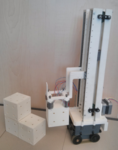allsey87
Member level 4
Hi All,
I need to generate a pulse about 250ms to 500ms wide at 24V. The application is to temporarily disable a magnetic field using a coil - the expected current at 24V is 500mA so we are talking about 12W.
The challenge is I need to run this from 3.3V supply without browning out the micro sharing the same supply, so I'm limited to drawing around 200mA from this supply (0.66W).
So I can come to a couple conclusions here, I need to 1/ step up my voltage, 2/ limit the downstream current draw to 200mA while charging a capacitor and 3/ discharge that capacitor using a 3.3V signal from the micro, while maintaining the 24V pulse for at least 250ms.
The final solution will go on a PCB and I'm looking for a fully/partially integrated solution to reduce the BOM as much as possible.
Any thoughts?
I need to generate a pulse about 250ms to 500ms wide at 24V. The application is to temporarily disable a magnetic field using a coil - the expected current at 24V is 500mA so we are talking about 12W.
The challenge is I need to run this from 3.3V supply without browning out the micro sharing the same supply, so I'm limited to drawing around 200mA from this supply (0.66W).
So I can come to a couple conclusions here, I need to 1/ step up my voltage, 2/ limit the downstream current draw to 200mA while charging a capacitor and 3/ discharge that capacitor using a 3.3V signal from the micro, while maintaining the 24V pulse for at least 250ms.
The final solution will go on a PCB and I'm looking for a fully/partially integrated solution to reduce the BOM as much as possible.
Any thoughts?
